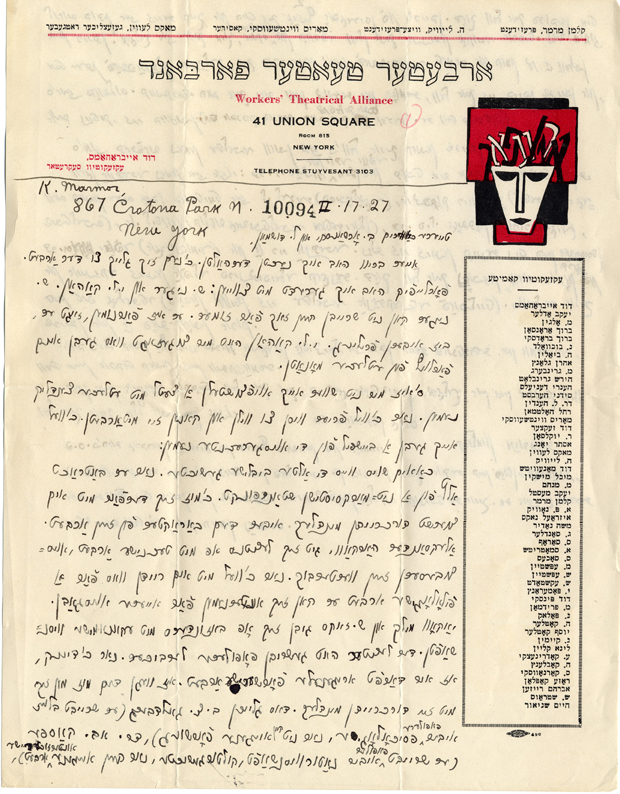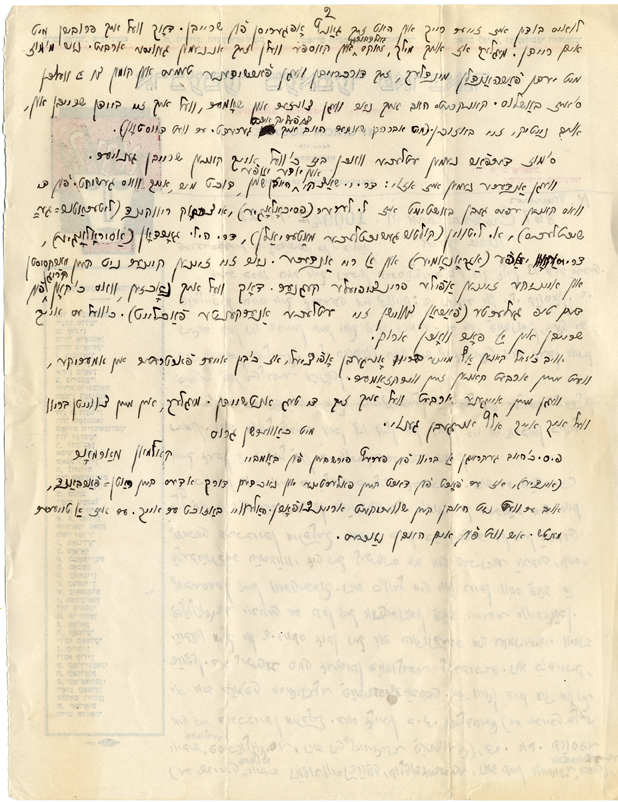Di gantse velt af a firmeblank: The World of Jewish Letterheads
Assemble the letterheads of Jewish organizations, institutions, and individuals in Europe, North and South America, and Palestine from the 1890s to the eve of World War II in 1939 and you have a portrait of the Jewish world: transnational; diverse in language, political, and religious orientation; and flourishing.
Di gantse velt af a firmeblank (The Whole World on a Letterhead) is an experiment in building that portrait. Here, we hope to bring you several times a month, a different example of letterhead from a single collection in the YIVO Archives, the Papers of Kalman Marmor.
Marmor, a Yiddish writer and cultural activist, was born October 11, 1879 in Mayshigola, Vilna Gubernia (today Maišiagala, Lithuania). In 1906, he settled in the U.S. Initially active with the Labor Zionist movement, he later became a Communist. He was an organizer of the 1937 World Yiddish Culture Congress, cultural director of the International Workers Order, and a contributor to the Communist Yiddish newspaper, Morgn Frayhayt. Between 1933 and 1936, he lived in Kiev, where he worked at the Institute of Jewish Proletarian Culture and prepared scholarly editions of the work of American Yiddish poets and writers. During Stalin’s Great Terror, the Institute was liquidated, and much of its leadership was arrested and executed. Marmor, an American citizen, returned to the U.S. He died in Los Angeles in 1956.
His papers at YIVO contain several thousand letters from the turn of the 20th century to the 1950s. He had an astonishingly diverse array of correspondents, not limited to Zionist and Communist activists.


From Kalman Marmor in the Bronx to Ber Orshansky and Leon Dushman in the USSR, February 17, 1927. (RG 205, Folder 122)
This letter appears to be a draft of a letter by Marmor to Ber Orshansky, a Soviet Yiddish writer and Jewish functionary in the Soviet Union, and Leon Dushman, a Jewish scholar in Minsk.. It is written on the letterhead of Artef (Arbeter teater farband – Workers Theater Alliance), a Communist Yiddish theater company, whose officers included Marmor (president) and the well-known Yiddish playwright H. Leivick (vice president).
Marmor discusses contributors to a periodical or literary collection that Orshansky and Dushman are trying to organize. He’s spoken to Shmuel Niger, the well-known literary critic, and folklorist Y.L. Cahan. Niger is too busy to write anything for the summer, but Cahan has promised to write something.
There are other possible contributors: Chaim Shoys knows biblical history but approaches his subject matter with a “non-Marxist perspective.” Alexander Harkavy is involved at the moment with revising his Yiddish-English dictionary, but Marmor will speak with him about “what sort of philological work he is able to undertake for your publications.”
He suggests Jacob Milch and Sh. Zaks for articles on economics. Both have written for popular publications and Zaks has written a textbook. But maybe what Orshansky and Dushman are looking for is “original, scholarly work.” The same could be said for journalist and educator (and son-in-law of Sholem Aleichem) Benzion Goldberg, who has written psychology for popular journals, but nothing based on original research, as well as for Dr. Ab. Kaspe, who writes popular articles on nature and cultural history. Marxist politician and theorist Louis Boudin “has become wealthy and stopped writing.”
The only firm commitments Marmor has managed to garner are from Zunser and Shomer [Charles Zunser and Miriam Shomer Zunser?]. He goes on to list other prominent writers and intellectuals he’s contacted, “but not a single one of them are Marxists” and some of them are even outright opposed to Marxism. He believes he could be more effective if Olshansky and Dushman will grant him permission to say that he is their official representative in America.
Marmor notes in a postscript that he’s received a letter from playwright Peretz Hirschbein, who is in Bombay and plans to go on from there to Palestine and afterwards to Odessa, as long as he doesn’t encounter difficulties getting into the USSR. He has suggested that they meet with Hirschbein and recommends him as “a great person [tayerer mentsh].”
Series curated by Roberta Newman; Images digitized by Vital Zajka. Biographical information on Kalman Marmor from biographical note by Daniel Soyer in the inventory to RG 205, Papers of Kalman Marmor.